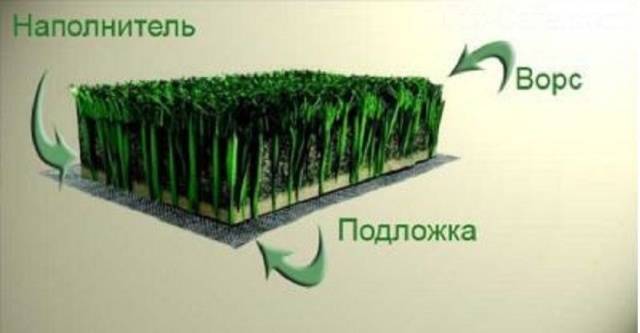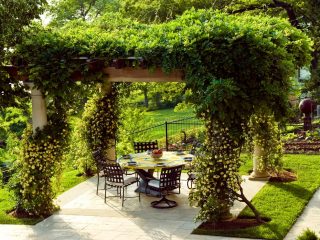Content
Currently, summer residents and owners of suburban areas pay a lot of attention to the improvement and decoration of their properties. After all, in addition to getting a good harvest, you always want to have a place to relax and realize creative inspiration. An excellent option that allows you to temporarily (after harvesting) or permanently decorate your area is artificial turf.
Modern production technologies provide such a natural look to artificial turf that it is almost impossible to distinguish it from natural grass. And if you also ensure proper installation and operation, you will immediately feel all the benefits.
An artificial lawn will ideally help out in situations where you urgently need to improve a place for a holiday, wedding, business meeting or corporate event in the open air. Natural grass is trampled, a large number of people can quickly reduce the decorative value of a regular lawn. In addition, artificial fiber is easy to spread in places where grass cannot grow, even indoors.
This is another significant advantage of artificial turf. Such a lawn works well on a sports ground and in animal walking areas.With the help of artificial turf it is easy to simulate a grass staircase or steps, and beautifully decorate the area under the terrace.
The choice in its favor is often determined by such advantages that significantly save time. Artificial turf does not require regularity:
- glaze;
- haircuts;
- fertilizing
That is, the basic care that a grass lawn requires is not needed in this case.
Among the important advantages of artificial grass, it should be noted that it:
- absolutely moisture resistant;
- does not provoke allergic manifestations (hypoallergenic);
- not destroyed by insects and pests;
- withstands direct sunlight (although it can get very hot) and frost;
- makes it possible to design areas of the most intricate shapes and in hard-to-reach places.
All these advantages will be clear to those summer residents who have a natural lawn on their property. Caring for it requires not only money and time, but also constant attention.
Types and characteristics of artificial turf
Artificial turf is made from piled plastic fiber - polypropylene or polyethylene. Depending on the material used, the degree of lawn hardness changes. Polyethylene fiber is more elastic and thinner, it is used on playgrounds, playgrounds, and football fields. Polypropylene has a stiffer pile, so it is used for sports fields (tennis, golf), where athletes do not often fall.
The appearance and texture of this grass are very similar to natural lawn. To notice this, you can look at the photo of the artificial turf.
The fiber is attached to a highly elastic base coated with latex.The pile height ranges from 6 mm to 100 mm, so it can be used for different purposes.
How artificial turf is made:
In addition to different heights, such a covering is distinguished by the density and direction of growth of the “blades of grass”. Depending on the purpose of the covering, artificial turf is divided into types:
Nezasypnoy
Serves exclusively for decorative purposes. The main difference between this type is the natural appearance. It is almost impossible to distinguish it from living grass. But it can only be placed in places with minimal load. In other words, you will have to walk on such a lawn sparingly and carefully. However, there are also distinctive advantages over other types - it does not require pouring quartz sand, and is highly aesthetic.
Half-fill
Suitable for sports and children's playgrounds.
The base is soft polyethylene fiber, and quartz sand is poured into the spaces between the fibers. This is done to increase the strength and stability of the lawn.
Backfill
The material for such a lawn is polypropylene. The villi are elastic, tough and stable. Used in public places, on football fields, where the load on the grass is very high. The base between the blades of grass is covered with special rubber granulate and quartz sand. The rubber filler softens friction, provides springiness and protects football players from injury.
Artificial turf has its own varieties and colors. The green lawn is used to decorate the plots.
For sports fields, coatings are available in white, yellow, blue, red, and brown. This eliminates the need for marking.
A strip of another color is wedged into a roll of one color, which looks quite natural. There is a two-color pile or one-color with different shades.
In addition to sports types of artificial turf, there are also decorative ones. They differ in the structure of the fibers. In this case, some fibers are long and straight, green in color. Others are twisted yellow. They give the coating good elasticity, so this type is produced without filler.
Flower artificial turf
A separate option is floral artificial lawn. In this coating, grass fibers are combined with decorative flowers, as in the photo:
Laying artificial turf on the site
Artificial turf is sold in rolls. Therefore, laying artificial turf with your own hands is quite affordable and uncomplicated. Although, for the first time you will definitely have to take the advice of professionals and be patient. The main installation steps include:
- Soil preparation. First of all, this includes putting things in order on the site. Remove debris, plant debris, stones, glass, and metal parts. Then the site is leveled and compacted. This operation is carried out with a log, a roller, or boards. When leveling the soil, be sure to maintain a slight slope to allow water to drain. If the lawn is laid on concrete or asphalt, then compaction is not required. But in this case you need a substrate. It has a small thickness (1 cm), but softens the load on the fibers well. There is no point in using a thinner underlay; it may press through, making the surface of the lawn uneven.
- Drainage device. This is necessary in order to prevent soil rotting. Artificial turf is not afraid of excess moisture, and the ground must “breathe.” Drainage ditches are located on the side of the slope, this will allow water to drain more easily.
- Roll stacking. The rolls are laid with an overlap (about 1.5 cm). Each roll is then trimmed to ensure the edges match very precisely and without creases.
- Curing and fastening. After unrolling the roll, the grass should straighten and acquire a vertical shape. This may take up to 12 hours. Then the rolls are fastened with staples and a special plinth around the perimeter. In the case of fragmentary design, the canvas is attached with glue. And in some cases this is not required.
Laying elements:
After laying and fastening, the lawn covering is shed with water. This is done for better adhesion of the lawn to the ground.
Rules of care
Maintenance of artificial turf is necessary to increase the life of the surface. It is not difficult, but it will retain the presentable appearance of the site for a long time. Basic conditions:
- Cleaning artificial turf. It needs to be washed and all dirt removed. It is advisable to carry out disinfection on the playground and indoors. This is done infrequently, as needed.
- Update. This applies to sand and granulate. They are updated no more than once every six months. If the lawn is used constantly, then it can be done more often.
- Hydration. This procedure is done during a long period of dry and hot weather to improve adhesion to the base.
- Aeration. Small punctures are made in the lawn once every two weeks. This reduces the accumulation of water and protects against rotting.
Conclusion
The main advantage of artificial turf remains the reviews from site owners. In their opinion, this is an excellent alternative to natural grass. It can be easily removed for the winter or moved to another location. Maintenance is much easier and cheaper. The combination of natural and artificial grass greatly simplifies the arrangement of areas.By following the basic recommendations, you can achieve a very long service life and preserve the decorative properties of artificial turf. In any case, the artificial lawn will meet all your hopes for high-quality design of the site.
















Good afternoon!!! please tell me how much it will cost 1 m2 of artificial 30-40 mm